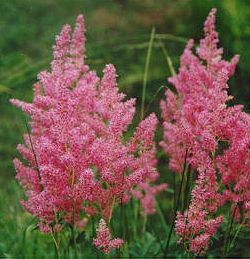Astilbe
Species

The
fern like foliage and the showy plume flowers
of False Spirea (Astilbe) make them a favorite
summer flowering perennial. The flower plumes
which appear in June and into July come in a variety
of colors ranging from pink, white, red and purple.
The most common varieties grow to a height of
about a foot and a half, but there are also taller
types which may reach five feet for the background,
and little 6 inch dwarfs which make nice groundcovers.
Even when they are not in bloom, the foliage stays
attractive throughout the summer, making them
very effective as a border plant, in the shade
garden, or at the side of your garden pond. Astilbe
are hardy to Zone 6.
Although
the Astilbe is generally considered to be a partial
to full shade plant, they appreciate a little
morning sun. They do, however need protection
from the hot afternoon sun. They should be planted
15-24 inches apart in good humus soil that is
rich in organic matter, and must be kept reasonably
moist at all times. Plants may be set in the garden
either in the Spring or in the Fall. Be sure to
provide good drainage for these plants if your
winters are wet, as they are here in the Pacific
Northwest Astilbes are heavy feeders and and should
receive periodic applications of 5-10-5 fertilizer
throughout the summer. They should be divided
every 3-4 years to keep them looking their best.
In early spring remove the debris from the previous
year, before new growth emerges. Astilbes are
propagated by division, or they may be grown from
seed started indoors in early March, or planted
directly into the garden in early Spring.
|
Astilbe,
also known as false spirea or meadowsweet, is a
native to China, Japan, and Korea. It is a shade
tolerant perennial that grows 2 to 3 feet tall although
some varieties can grow to a height of 4 feet. Bloom
occurs from early June through August depending
upon the cultivar. Flowers are available in white
and various shades of pink, red, or lavender. The
genus Astilbe is composed of approximately 25 species.
Astilbe grows best in full sun or partial shade.
They require a consistent supply of moisture to
prevent browning of the leaf margins. Astilbe also
require well drained soils, they do not perform
well in heavy, clay. Around the pool they can be
bogged or container planted, in a one gallon pot
or larger. The pots should be placed so only about
the bottom 2 inches of the pot are submerged. Fertilize
in the spring with a slow release fertilizer according
to label directions. A fertilizer ratio of 3-1-2
is preferred. Astilbe are quite pest free. Although
powdery mildew, wilt and spider mites have been
reported, control is seldom necessary. In the landscape,
astilbe usually need division every 4 years or so.

|


